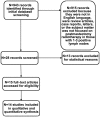Improvement of survival with postmastectomy radiotherapy in patients with 1-3 positive axillary lymph nodes: A systematic review and meta-analysis of the current literature
- PMID: 27699038
- PMCID: PMC5038196
- DOI: 10.3892/mco.2016.971
Improvement of survival with postmastectomy radiotherapy in patients with 1-3 positive axillary lymph nodes: A systematic review and meta-analysis of the current literature
Abstract
In breast cancer with >4 positive axillary lymph nodes, it is common practice to deliver radiotherapy to the affected site following mastectomy. However, less is known regarding the benefits this may confer on women with 1-3 positive lymph nodes. In this meta-analysis, we aimed to assess whether post-mastectomy radiotherapy (PMRT) was beneficial for such patients. A literature review was conducted using the PubMed and Ovid databases. Selected studies were analysed and data regarding overall survival (OS) and locoregional recurrence (LRR) rates were extracted. Statistical analysis was then conducted in order to develop a combined risk ratio (RR) for both OS and LRR in the setting of PMRT in women with breast cancer with 1-3 positive lymph nodes. PMRT in women with 1-3 positive lymph nodes significantly reduced the risk of LRR, with a RR of 0.3 [95% confidence interval (CI): 0.23-0.38] and also showed a minor benefit in terms of OS (RR=1.03, 95% CI: 1.00-1.07). Therefore, in breast cancer patients with 1-3 positive lymph nodes, PMRT significantly reduced the risk of LRR and was associated with a minor OS benefit. Until the results of ongoing randomised controlled trials are published, PMRT should be recommended in this group of patients following a careful multidisciplinary discussion.
Keywords: axillary lymph nodes; breast cancer; postmastectomy radiotherapy.
Figures



References
-
- Wenz F, Sperk E, Budach W, Dunst J, Feyer P, Fietkau R, Haase W, Harms W, Piroth MD, SautterBihl ML, et al. Breast Cancer Expert Panel of the German Society of Radiation Oncology (DEGRO): DEGRO practical guidelines for radiotherapy of breast cancer IV: Radiotherapy following mastectomy for invasive breast cancer. Strahlenther Onkol. 2014;190:705–714. doi: 10.1007/s00066-014-0687-0. - DOI - PubMed
-
- Dewis R, Gribbin J. National Institute for Health and Clinical Excellence clinical guidelines. National Collaborating Centre for Cancer; Cardiff (UK): Feb, 2009. Breast Cancer: Diagnosis and treatment. An assessment of need. - PubMed
-
- EBCTCG (Early Breast Cancer Trialists' Collaborative Group) McGale P, Taylor C, Correa C, Cutter D, Duane F, Ewertz M, Gray R, Mannu G, Peto R, et al. Effect of radiotherapy after mastectomy and axillary surgery on 10-year recurrence and 20-year breast cancer mortality: Meta-analysis of individual patient data for 8135 women in 22 randomised trials. Lancet. 2014;383:2127–2135. doi: 10.1016/S0140-6736(14)60488-8. - DOI - PMC - PubMed
-
- Nordenskjöld AE, Fohlin H, Albertsson P, Arnesson LG, Chamalidou C, Einbeigi Z, Holmberg E, Nordenskjöld B, Karlsson P. Swedish Western and Southeastern Breast Cancer Groups: No clear effect of postoperative radiotherapy on survival of breast cancer patients with one to three positive nodes: A population-based study. Ann Oncol. 2015;26:1149–1154. doi: 10.1093/annonc/mdv159. - DOI - PubMed
LinkOut - more resources
Full Text Sources
Other Literature Sources
